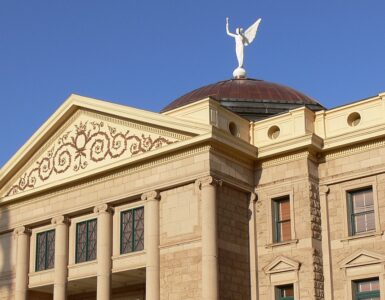Consider making reservations for three this Thursday as Arizona celebrates another year of statehood!
February 14 — Valentine’s Day — marks Arizona’s 107th birthday, and while its statehood may still be in its honeymoon phase, the history of the Grand Canyon State spans a millennia of growth and progress.
“For 107 years, people have chosen to make Arizona their home, attracted by its boundless opportunity, magnificent landscapes, rich heritage, endless days of sunshine and more,” Gov. Doug Ducey said in a statement Thursday, declaring Feb. 14, 2019 as Arizona Statehood Day.
“Today, we’re celebrating everything that makes Arizona a fantastic place to live,” Ducey said. “From our pioneering spirit to our warm hospitality, from every corner of our state, every snow-capped peak and cactus-strewn valley, there is simply no better state in the country. I am incredibly grateful to call Arizona home and excited to see what the future of Arizona holds.”
Arizona saw its first settlers around 9000 B.C. in the form of Paleo-Indian hunter-gatherers migrating from northern Asia across the land-and-ice bridge to what is now the northwestern United States.
By 1500 B.C., Native Americans in present-day Arizona began building irrigation systems for farming in the desert, and in 1539 Jesuit Franciscan explorer Marcos de Niza led an expedition through eastern Arizona.
The Territory of Arizona was founded on Feb. 24, 1863, with Prescott as the capital. The state seat of government moved to Tucson in 1867 and back to Prescott in 1877 before finally settling in Phoenix in 1889, where it has remained to this day. On Feb. 14, 1912, Arizona became the 48th state of the Union.
Phoenix began developing in the 1860s when residents organized a plan to use ancient Hohokam canals to irrigate the Salt River Valley, and the city was incorporated in 1881.
Arizona’s prosperous mining industry drew thousands of settlers to the region, and many of the state’s rural towns and cities were originally founded by miners seeking fortunes. Today’s mining industry is much different from the early days, but Arizona mining still adds nearly $6 billion to the Arizona economy.
In 1903, Dwight Heard, a well-known rancher and president of the Arizona Cotton Association, joined forces with several other prominent Phoenix residents to form the Salt River Water Users’ Association (now the Salt River Project) and built the Roosevelt Dam in 1911 to combat summer droughts that were impeding farming in the Valley. During World War I, cotton became the state’s number one crop.
Historic fighter pilot and Phoenix resident Lieutenant Frank Luke, Jr., flew into battle in 1917 and became a national legend with 18 victories against German forces. Luke was the first American airman to receive a Medal of Honor for his service in World War I, and Luke Air Force Base in Glendale is named in his memory.
President Theodore Roosevelt created the Grand Canyon Game Preserve national monument in 1906, which was incorporated into the Grand Canyon National Park in 1919. The park now sees about six million domestic and international visitors annually and is celebrating its centennial later this month.
In 1962, University of Arizona graduate and five-term U.S. Senator Barry Goldwater became the first Arizonan to win a party nomination for president with a nod from the Republican party. In 2016, the Arizona Air National Guard base at Phoenix Sky Harbor International Airport was renamed in honor of the late senator.
“In uniform and in politics, Barry’s purpose was always the defense of freedom, and nobody, before or since, managed the task more ably or more colorfully than Barry Goldwater,” said Sen. John McCain, who succeeded Goldwater’s senate seat in 1987, in a eulogy after Goldwater’s death in 1998. “He held his principles close to his heart, where he held his love of country.”
In 1966, Arizona native Ernesto Miranda was arrested and convicted of kidnapping and rape based on a confession that was later overturned by the U.S. Supreme Court in Miranda vs. Arizona. The historic case resulted in the Miranda Warning — “You have the right to remain silent…” — which police are required to state when making an arrest to prevent suspects from incriminating themselves.
In 1981, former Arizona senator and Superior Court judge Sandra Day O’Connor became the first woman appointed to the U.S. Supreme Court.
Rose Mofford was born and raised in Globe, Arizona. After graduating as class valedictorian in 1939 from Globe High School, she moved to the Valley to begin her career as a secretary in the state government.
Almost 40 years later, she became Arizona’s first female Secretary of State when she was appointed by Gov. Wesley Bolin in 1977; Mofford had previously been Bolin’s executive secretary when he served as Secretary of State. When Gov. Evan Mecham was impeached on Feb. 8, 1988, Mofford ascended to Mecham’s seat and became Arizona’s first female governor.
Although Arizona is traditionally known as a Republican state, the Democrat Mofford was well-liked by people on both sides of the aisle for her bipartisanship and her friendly demeanor, according to the Los Angeles Times.
Ed Pastor, an Arizona State University graduate from Claypool, Arizona, was a teacher, activist and lawyer who served three terms on the Maricopa County Board of Supervisors. In 1991, Pastor ran against a retiring incumbent Democrat congressman in the Second Legislative District, which at the time covered much of southwestern Arizona as well as parts of Phoenix and half of Tucson.
Pastor won the first election by 1,800 votes, and a month later he won the special election with 55 percent of the votes to become the first Latino congressman from Arizona.
In 1996, Arizona saw its first Super Bowl football game: the Dallas Cowboys played the Pittsburgh Steelers at ASU’s Sun Devil Stadium in Tempe. The Cowboys defeated the Steelers 27-17, tying the San Francisco 49ers for the record for most Super Bowl wins and becoming the first National Football League team to win three Super Bowls in four years.
Not long after, in 1998, Arizona entered the Major League Baseball scene. On March 31, 1998, the Arizona Diamondbacks played their first game against the Colorado Rockies at Bank One Ballpark in Phoenix, which has since been renamed Chase Field.
Just a few years into the team’s career, the Diamondbacks represented the National League in the 2001 World Series and beat the New York Yankees, another first for Arizona.
In January 2019, two U.S. congresswomen were sworn in as Arizona’s first female senators. Sen. Kyrsten Sinema (D) — who is also the first openly bisexual member of the Senate — was elected in November 2018 and is senior to Sen. Martha McSally (R), who Gov. Ducey appointed to fill Sen. McCain’s vacant seat.
McSally, a graduate of the U.S. Air Force Academy, was the first female pilot to fly a fighter jet in combat and command a fighter squadron during her more than 20 years of military service.
As Arizona’s population continues to grow, it remains clear that Arizonans aren’t the only ones falling in love with the Valentine state.
Arizona celebrated 100 years of statehood in 2012, and in the preceding century the state’s population grew from 200,000 to about 6.5 million.
Arizona has come a long way since the days of horse-drawn wagons, ancient irrigation systems and hand mining.
Top industries in the state include aerospace and defense engineering and manufacturing; technology, including autonomous vehicles, computer hardware and software development; health care and bioscience; and financial services, including new FinTech and blockchain technologies.
Arizona is considered first in the nation for entrepreneurial activity, boasting significant job and wage growth and a GDP of more than $326 billion.
This year, Keep Nature Wild, a Mesa-based apparel company and wildlife advocacy group dedicated to keeping natural areas trash-free, is celebrating statehood day with the second-annual Arizona Birthday Cleanup at South Mountain Park and Preserve in Phoenix on February 16.
The 2018 cleanup drew more than 400 volunteers who removed 11,350 pounds of trash from South Mountain Park and Preserve, which is the largest municipal park in the U.S.
Keep Nature Wild removes one pound of trash for every product sold and aims to eliminate one million pounds of trash from natural areas by 2023, according to the company’s website.
















Great article – Arizona has a lot to be proud of!